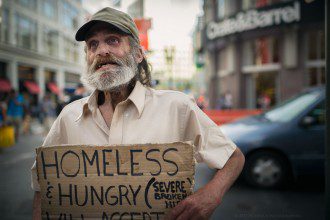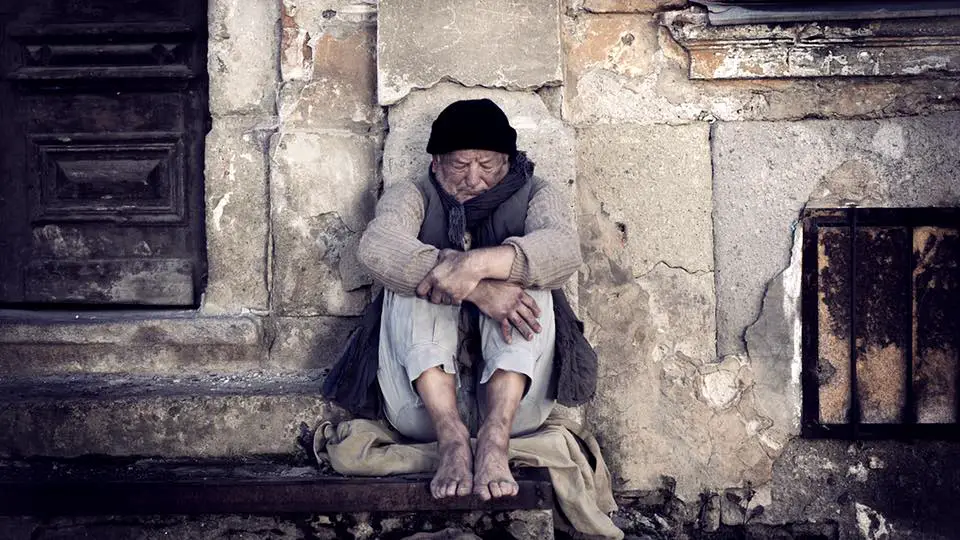Contributing Writer for Wake Up World
During a balmy 60ºF December morning, Rene Zepeda is driving a Volunteers of America minivan through Salt Lake City, Utah, looking for the homeless who may be camping by the railroad tracks or over by the river, sometimes in the foothills. Cold weather is on its way, so the van is packed with sleeping bags, thermal clothing, coats, sock, boots, hats, protein bars, nutrition drinks and canned goods. According to Rene, once the day is finished, everything will be gone. “I want to get them into homes,” he says. “I tell them, ‘I’m working for you. I want to get you out of the homeless situation.’”
Rene works for a program called Housing First. It has decreased the number of homeless by an extraordinary 72% — mainly by providing permanent free housing. Critics bemoan the expense, but once the numbers were thoroughly crunched, it was discovered the program actually costs the state far less than if people were left on the street. Moreover, in a nation where a large proportion of the homeless population are military veterans, adopting such a program is not only a social or financial imperative but a moral one.
The brutal reality of homelessness
One of the first people Rene comes across in his morning travels is William Miller, 63, who was diagnosed with liver cancer. For the last two nights, his home has been under a freeway viaduct. Vomiting as soon as he wakes in the morning, he also has gone through two sets of clothing due to diarrhea. Rene will take him to a free clinic so that he can get proper care.
Next is a camp by the railroad tracks, where a 57-year-old man and a 41-year-old woman live in a three-person tent covered with plastic tarps. Patrick has had several strokes this year and two tumors growing in his lung. He walks with a cane.
“My legs are going out. I’m sure it’s from camping out. We were living in the hills for two years,” he says. “My girlfriend, Charmaine, is talking about killing herself she’s in so much pain.” Charmaine is a heroin addict who suffers from diabetes, grand mal seizures, cirrhosis, and heart attacks. “When we lived in the foothills we both got bit by poisonous spiders,” she says, showing me a three-inch scar above her swollen right ankle. “The doctor tried to cut out the infection, but he accidentally cut my calf muscle.” [source]
As Rene is helping Charmaine into the van, Patrick asks if Rene could find her a subsidized apartment for the homeless. “If she comes back here she’ll die,” he says. “Especially with the cold weather coming.”
Rene says he will look into it.
Real solutions for getting people off the street
Housing First provides stability for homeless people in a way that is far different from shelters and halfway houses. It gives access to permanent housing — unconditionally.
 It began in Utah as a 10-year project to eliminate homelessness. State legislators were hesitant, but eventually embraced the idea. When the cost of emergency room visits, police intervention, shelters and halfway houses were taken into consideration, it was found that providing permanent housing was much more cost effective. Before Housing First, Utah was spending around $20,000 a year for each chronically homeless person. But with the program in full-swing, the state saves an impressive $8,000 per person. “We’ve saved millions with this,” said Gordon Walker, director of the state Housing and Community Development Division. Today, the project is close to eradicating homelessness in the state.
It began in Utah as a 10-year project to eliminate homelessness. State legislators were hesitant, but eventually embraced the idea. When the cost of emergency room visits, police intervention, shelters and halfway houses were taken into consideration, it was found that providing permanent housing was much more cost effective. Before Housing First, Utah was spending around $20,000 a year for each chronically homeless person. But with the program in full-swing, the state saves an impressive $8,000 per person. “We’ve saved millions with this,” said Gordon Walker, director of the state Housing and Community Development Division. Today, the project is close to eradicating homelessness in the state.
The brainchild is credited to Sam Tsemberis, a psychologist at New York University, who formulated the idea of ending homelessness through unconditional housing.
“Okay,” Tsemberis recalls thinking, “they’re schizophrenic, alcoholic, traumatized, brain damaged. What if we don’t make them pass any tests or fill out any forms? They aren’t any good at that stuff. Inability to pass tests and fill out forms was a large part of how they ended up homeless in the first place. Why not just give them a place to live and offer them free counseling and therapy, health care, and let them decide if they want to participate? Why not treat chronically homeless people as human beings and members of our community who have a basic right to housing and health care?” [source]
 Tsemberis and his team, through their group Pathways to Housing, ran a test where they provided apartments for 242 chronically homeless people, no strings attached. They could do whatever they wanted — drink, take drugs, have mental breakdowns — as long as they didn’t hurt anyone. Services were provided if they wanted rehab, detox or medical care. But it was completely their choice.
Tsemberis and his team, through their group Pathways to Housing, ran a test where they provided apartments for 242 chronically homeless people, no strings attached. They could do whatever they wanted — drink, take drugs, have mental breakdowns — as long as they didn’t hurt anyone. Services were provided if they wanted rehab, detox or medical care. But it was completely their choice.
The results were astonishing. After five years, 88% of the participants were still living in their apartments with minimal issue. A subsequent study showed the care of mentally ill homeless in New York City averaged $40,449 a year with emergency room visits, shelter and other expenses, and transferring those people off the street and into supportive housing saved around $16,282. Many cities and states around the nation have adopted similar programs, including Seattle and Portland, Maine, as well as Rhode Island and Illinois. Denver found that “emergency-service costs alone went down 73 percent for people put in Housing First, for a savings of $31,545 per person; detox visits went down 82 percent, for an additional savings of $8,732,” as stated by Mother Jones. And Medicine Hat in Alberta, Canada has had similar success after reaching a zero-homelessness goal late last year by providing permanent housing.
One chronically homeless woman in Utah needed a fair amount of convincing before moving into the housing. “She didn’t trust it, and she put her collection of stuff on the bed. Then for the next two weeks, she slept on the floor,” Walker said. “But once she realized that we weren’t going to take this from her, that she had a lock, she had a mailbox, she started to re-acclimatize.”
Article sources
- www.motherjones.com/politics/2015/02/housing-first-solution-to-homelessness-utah
- www.washingtonpost.com/news/inspired-life/wp/2015/04/17/the-surprisingly-simple-way-utah-solved-chronic-homelessness-and-saved-millions/
- www.cbc.ca/radio/asithappens/wednesday-msf-united-nations-south-sudan-blue-whale-deaths-poe-statue-and-more-1.2903897/a-groundbreaking-study-suggests-giving-homeless-canadians-homes-first-saves-money-1.2903898
- www.cbc.ca/radio/asithappens/as-it-happens-thursday-edition-1.3074402/medicine-hat-becomes-the-first-city-in-canada-to-eliminate-homelessness-1.3074742
- www.huffingtonpost.ca/2015/05/14/medicine-hat-homelessness-end-2015_n_7280232.html
- www.businessinsider.com/this-state-may-be-the-first-to-end-homelessness-for-good-2015-2
About the author:
 Carolanne Wright enthusiastically believes if we want to see change in the world, we need tobethe change. As a nutritionist, natural foods chef and wellness coach, Carolanne has encouraged others to embrace a healthy lifestyle of organic living, gratefulness and joyful orientation for over 13 years.
Carolanne Wright enthusiastically believes if we want to see change in the world, we need tobethe change. As a nutritionist, natural foods chef and wellness coach, Carolanne has encouraged others to embrace a healthy lifestyle of organic living, gratefulness and joyful orientation for over 13 years.
Through her website Thrive-Living.net, she looks forward to connecting with other like-minded people from around the world who share a similar vision.
You can also follow Carolanne on Facebook, Twitter and Pinterest.
Further reading from Carolanne Wright:
- Seed Bombs: A Creative (and Fun) Mission to Save the Bees and Butterflies
- Mind Control, Subliminal Messages and the Brainwashing of America
- Autistic Boy with Higher IQ Than Einstein Discovers Gift After Removal from State-Run Therapy
- Monsanto Charged with Crimes Against Nature and Humanity – Set to Stand Trial in 2016
- Dr Sebi: The Man Who Cures Aids, Cancer, Diabetes and More
- Politicians in California May Soon be Forced to Wear Corporate Sponsor Patches Like Nascar Drivers
- Plastic-Eating Mushroom Discovered in the Amazon Rainforest — A Solution for Our Trash Saturated World?
- Big Pharma and Organized Crime — They are More Similar Than You May Think
- Over 100 Scientific Studies Agree: Cannabis Annihilates Cancer
- Emotional Energetic Healing: The Future of Medicine is Here
- Why Every Parent Should Consider Unschooling
- The Greenhouse of the Future: Grow Your Own Food Year-Round With This Revolutionary System
- First U.S. City Produces More Electricity Than It Uses — With 100% Renewable Technology

If you've ever found value in our articles, we'd greatly appreciate your support by purchasing Mindful Meditation Techniques for Kids - A Practical Guide for Adults to Empower Kids with the Gift of Inner Peace and Resilience for Life.
In the spirit of mindfulness, we encourage you to choose the paperback version. Delve into its pages away from screen glare and notifications, allowing yourself to fully immerse in the transformative practices within. The physical book enriches the learning process and serves as a tangible commitment to mindfulness, easily shared among family and friends.
Over the past few years, Wake Up World has faced significant online censorship, impacting our financial ability to stay online. Instead of soliciting donations, we're exploring win-win solutions with our readers to remain financially viable. Moving into book publishing, we hope to secure ongoing funds to continue our mission. With over 8,500 articles published in the past 13 years, we are committed to keeping our content free and accessible to everyone, without resorting to a paywall.









